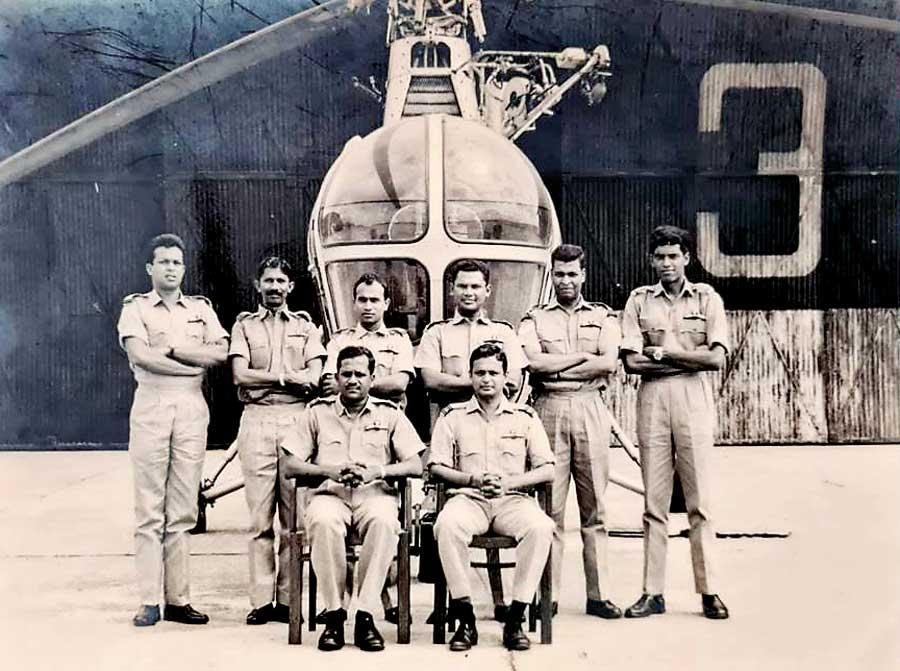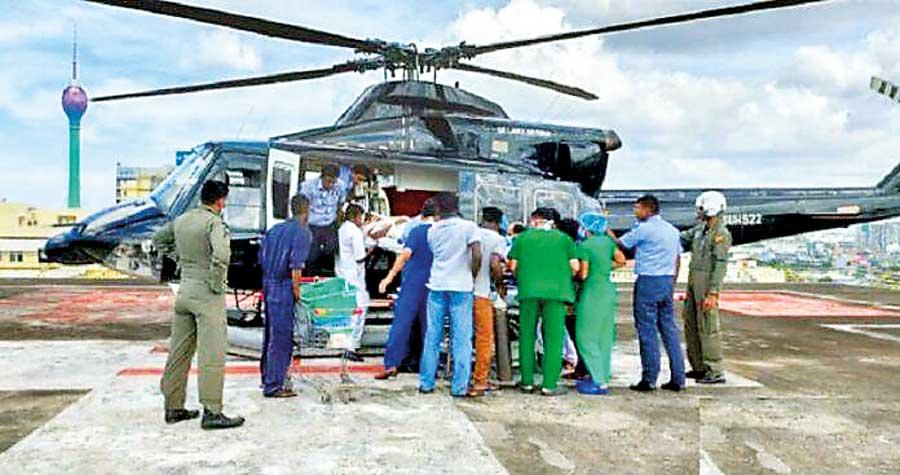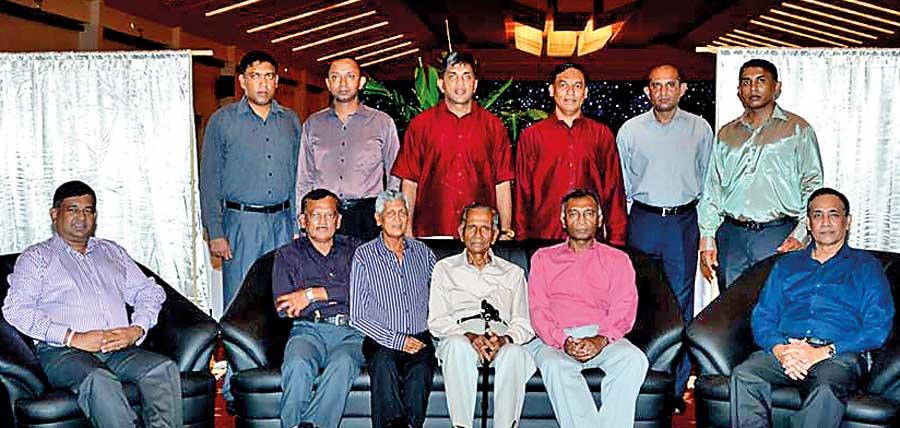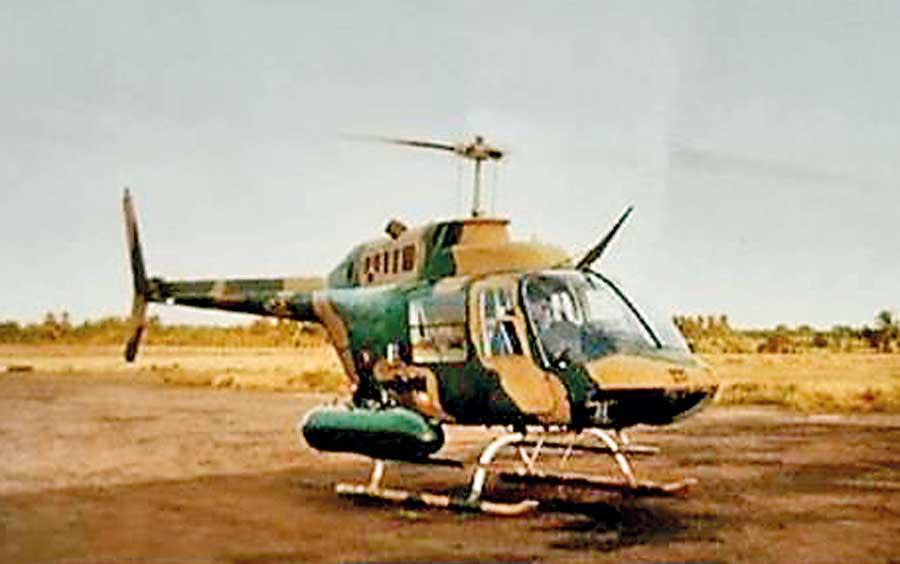Reply To:
Name - Reply Comment

Pilots of the No 4 Squadron early 1970s
RWP RSP VSV USP MPhil MSc FIM ndc psc.
Formerly
Commander Sri Lanka Air Force
Ambassador to Afghanistan
President Association of Retired Flag Rank Officers
The realm of the No 4 Squadron, a distinguished legacy soars above the rest. Comprising skilled aviators, technically savvy engineers and technicians, advanced helicopters, and an unwavering commitment, this elite squadron stands as a paragon of VVIP conveyance. The squadron celebrated its 58th anniversary on 1st June 2023. The No 4 Squadron has grown in expertise and reputation as the most experienced Helicopter squadron in the Sri Lanka Air Force. Further, the No 4 Squadron was acknowledged as the “Home of the Helicopter Pilots”.
At the heart of this elite squadron is a fleet of well-equipped helicopters. These airborne marvels are a testament to engineering prowess, offering unparalleled safety, comfort, and reliability. The squadron’s pilots, engineers, and technicians are selected and trained rigorously. In addition, they possess an unrivalled mastery of their craft, ensuring every mission is executed flawlessly. The Squadron’s protocols and procedures are stringently designed to exceed the highest standards, ensuring the care of their distinguished and precious human cargo to their destinations with safety. The purpose of this write-up is to serve as a means of preserving knowledge and insights from the past of No 4 Squadron and also to preserve valuable information for the understanding of the younger generations. It could also inspire the younger generations to pursue their passions and goals.
In addition, it showcases the progress that has been made by the No 4 Squadron to help the younger generations feel a connection to their heritage and a sense of identity and belonging. I hope this will create a bridge between generations, fostering a sense of continuity and shared wisdom. Let me walk you through this discourse to unveil, the path of progress of the No 4 Squadron through dedication and prowess over 58 years.

Bell 412 landed on the roof top helipad the National Hospital, Colombo on a MEDEVAC
Early days
The first helicopter that entered the RCyAF inventory was the Westland Sikorsky S 51 Dragonfly in 1956, which was then flown by the Royal Navy, especially on search and rescue. The RCyAF pilots S M V Situnayake and M A De Soysa were the first two pilots to be trained on helicopters, both of them retired later as Squadron Leaders. Their helicopter flying training was carried out in Ceylon by Commander Sproule of the Royal Navy. Subsequently, in 1965 Squadron Leader M A De Soysa commanded the first-ever helicopter entity in RCyAF as the No. 4 Helicopter Flight.
Then in 1970 Squadron Leader AW Fernando took command of the No. 4 Helicopter Flight with three Bell Jet Ranger 206 CH 550, 551, 552. On 15th January 1971, a significant transformation took place when the No. 4 Helicopter Flight was graduated and redesignated as No. 4 Helicopter Squadron and continued to remain under the command of Squadron Leader AW Fernando with Bell 206 Jet Ranger helicopters. The role of this squadron was mainly VIP transport, reconnaissance, cargo transport, air/sea, and jungle rescue. After Squadron Leader AW Fernando nine (09) other pilots commanded the No. 4 Helicopter Squadron namely; Sqn Ldr OM Paul, Sqn Ldr NR Rahim, Flt Lt HMP Goonatillake, Wg Cdr HK Caldera, Sqn Ldr WPA Jayasinghe, Sqn Ldr S Manamperi, and the last to command the No. 4 Helicopter Squadron was Wg Cdr OM Ranasinghe up to 31st Dec 1986. Flt Lt HMP Goonatillake and Sqn Ldr WPA Jayasinghe had two stints of command. During this period six 206 Bell Jet Rangers, two Kamov KA-26, two SA-365C Dauphins, thirteen Bell 212s, and four Bell 412s had been inducted at different stages to the No 4 Squadron.

Commanding officers of the No 4 Squadron at the squadron’s 50th Anniversary celebration reception
Fleet Expansion
In addition, the most significant inductions to the No 4 Helicopter Squadron during this period were the two Bell 206 Jet Rangers and the two Bell 212s in 1984. Of these inductions, the new Bell 206 jet Rangers were configured as high-skid armed gunships with forward-firing 12.7mm HMP (Heavy Machine Gun Pod) and a Folding-Fin Aerial Rocket (FFAR) 7-Tube 70 mm (2.75”) rocket launcher. This armed configuration brought a gunnery phase to the Jet Ranger helicopter training syllabus. Armed Jet Ranger Helicopters were initially deployed in the north. The new Bell 212s inducted were in VIP configuration.
Eelam War I, the initial phase of the conflict with the LTTE broke out with the attack on a Sri Lanka Army patrol in Jaffna, on July 23, 1983, that killed 13 soldiers. This attack and the subsequent riots in the south were considered as the beginning of the conflict. This fighting continued until 1985, when peace talks were held between the two sides in Thimpu, in the hope of seeking a negotiated settlement but proved fruitless, and fighting soon resumed.
At the inception of the conflict, only a Bell 206 Jet Ranger was attached to Palay on reconnaissance and gunship roles. As the hostilities intensified the security forces were faced with stiff restrictions on movements on land routes due to the landmine threat posed by the LTTE dominance. The satellite security force establishments in the north became air-dependent, which made a logistical nightmare for the SLAF.
With the increasing demand for logistics, the role of the Bell 206 Jet Range became redundant. The Bell 206 Jet Range deployed was supplemented with a SA 356 Dauphine helicopter. However, the payload of the SA 356 Dauphine was barely adequate to cater to the ever-increasing deployment in the peninsular. The need for the induction of a higher load-carrying capable helicopter to sustain the security forces in the north was well identified. By that time in 1984 two Bell 212s that had a higher lifting capacity had been inducted for VVIP transport in the SLAF. The capability of the Bell 212 and its flying characteristics was mastered and proven to the pilots within the SLAF by that time.
Also, the engineers had a fair knowledge and were competent in the maintenance aspects. Due to this reason ACM DC Perera, then Commander was able to convince the government of the need for the induction of more Bell 212 helicopters to the SLAF fleet. The Government accepted the proposition and approved the acquisition of six (06) Bell 212s in 1985. With these new inductions, the helicopter fleet expanded to meet operational needs in 1985. In 1985 after the induction of the Bell 212s the deployment of helicopters was initially made in Palay and Anuradhapura. The Helicopter deployed at Anuradhapura was re-located in Vavuniya subsequently as it reduced the flying time to the security force establishments that were north of Present Squadron Logo Bell 206 jet Rangers (high-skid) configured as armed gunships in Vavuniya. With the unfolding of the heightened tempo of operations, the need for the deployment of Helicopters in the eastern sector had arisen and Bell 212s were deployed in China-Bay and Batticaloa airfields.

Westland Sikorsky S 51 Dragonfly Helicopter
Graduating to a Wing
Further in 1987, No 4 Helicopter Squadron graduated as No 4 Helicopter Wing under the command of then Gp Capt OM Ranasinghe, and five (05) other pilots after him commanded the No 4 Helicopter Wing namely; Sqn Ldr J Weerakody, Wg Cdr LSB Cabral, Sqn Ldr CR Weerasinghe who was killed in the Avro crash on April 1995 and was posthumously promoted to the Rank of Group Captain followed by Wg Cdr WDRMJ Goonatillake and Sqn Ldr GP Bulathsinghala.
In 1994, an operational decision was made to split the No. 4 Helicopter Wing into two Squadrons as the 401 and 402 squadrons for the ease of operational control and forward deployment. The No. 401 Squadron took charge of operational flying requirements and helicopter pilot training and was located at SLAF Hingurakgoda with the Bell 212 and Bell Jet Ranger helicopters in its fleet. This squadron was later renamed as the No. 7 Helicopter Squadron in July 1996. The No. 402 Squadron remained under my command at SLAF Katunayake. We flew Bell 412s and the Bell 206 Jet Rangers, mainly for the VVIP/VIP commitments along with reconnaissance, special operations such as firefighting, underslung operations, search and rescue, and commercial flights. In 1996 again the No 402 Squadron reverted to its original designation as in 1987 as the No 4 Helicopter Squadron and I continued to command the squadron. After me, five (05) other pilots commanded the No 4 Helicopter Squadron namely; Wg Cdr CR Gurusinghe, Wg Cdr SR Gunaratne, Wg Cdr MDAP Payoe, Wg Cdr RS Dharmawardena, Wg Cdr VB Edirisinghe.
In 2011, the locations of the No 2 Transport Squadron and the No 4 Helicopter Squadron were interchanged between Ratmalana and Katunayake based on the principle of economy of effort. This gave the leverage for the fixed-wing aircraft to carry a higher payload from a longer runway Commanding officers of the No 4 Squadron at the squadron’s 50th Anniversary celebration reception with added safety and reducing the flying time to the destinations in the north. At the same time for the Rotary wing helicopters, the gain was that all helicopter flights originated from the city of Colombo and it reduced the total flying by the reduction in positioning distance/time from Ratmalana to Colombo City.
The No 4 Squadron once shifted to Ratmalana continued to remain under the command of Wg Cdr VB Edirisinghe. Five (06) other pilots have commanded the squadron namely; Wg Cdr LH Sumanaweera, Wg Cdr LC Dissanayake, Wg Cdr MASK Maheepala, Gp Capt KADAC Kuruwita, and Gp Capt DL Hewawitharana being the incumbent Commanding officer after that.

Bell 206 jet Rangers (high-skid) configured as a armed gunships
Expanding the Role
Offshore flying is a new dimension that was added to the No 4 Squadron role in January 2010. This operation was
|
Display of names of Commanding Officers |
required to transfer seafarers, offshore, and energy-related professionals. The Bell 412 operation fitted with flotation gear has been carried out successfully after being evaluated and certified as per the OGP safety standards. The Helicopter offshore operations to and from offshore locations, including helidecks, ships, and windfarms, pose certain specific safety risks that are required to be adequately addressed regularly to mitigate risks and maintain high safety levels. This new aspect of operation earned a considerable amount of foreign exchange to the government.
Further, the squadron was upgraded with a fully-fledged one-patient Air Ambulance Quick Change medical interior kit. This induction was a requirement for the 2013 Commonwealth Heads of Government Meeting (CHOGM) held in Colombo for emergency medivac of heads of government.
In furtherance of the Air Ambulance capability in 2022, the No 4 Squadron reached out further when a Memorandum of Understanding (MOU) was signed between the Sri Lanka Air Force and the Ministry of Health. Operationalizing this MOU, the squadron airlifted a brain-dead patient from Badulla to Colombo on October 31st, 2022. The victim, who had met with an accident, was airlifted in a Bell-412 helicopter air ambulance from the Badulla General Hospital to the National Bell 412 landed on the rooftop helipad of the National Hospital, Colombo on a MEDEVAC Hospital Colombo to retrieve his vital organs. The organs were expected to be donated to recipients, especially for heart transplant surgery conducted by the National Hospital, Colombo.
Pride of Command
For any rotary-wing pilot in the Sri Lanka Air Force commanding the No 4 Helicopter Squadron has been a very prestigious opportunity being the oldest helicopter entity. Also, it is considered a very selective appointment due to the sensitivity of the passengers mainly the VVIP passengers. It’s the facade of the SLAF in terms of exposure to the higher echelon of principals.
So far five Commanding Officers’ of No 4 Helicopter Squadron have ascended to the pinnacle and commanded the SLAF. They are namely, Squadron Leader AW Fernando ascended as the 7th Commander of Air Force and retired in the rank of Air Chief Marshal, and Gp Capt OM Ranasinghe, who ascended to be the 9th Commander of the Air Force and retired in the rank of Air Chief Marshal.
|
Present Squadron Logo |
Sqn Ldr J Weerakody ascended as the 10th Commander of the Air Force and retired in the rank of Air Chief Marshal, Wg Cdr WDRMJ Goonatillake ascended as the 12th Commander of Air Force and retired in the rank of Air Chief Marshal who was subsequently promoted to the rank of Marshal of the Air Force and Sqn Ldr GP Bulathsinghala became the 15th Commander of the Air Force and retired in the rank of Air Chief Marshal. Further, the remainder of the Commanding Officers Wg Cdr CR Gurusinghe retired from the Air Force as the Chief of staff in the rank of Air Vice Marshal, Wg Cdr SR Gunaratne, retired as an Air Commodore, Wg Cdr MDAP Payoe, retired from the Air Force as the Chief of staff in the rank of Air Vice Marshal, Wg Cdr RS Dharmawardena retired from the Air Force as a Group Captain Wg Cdr VB Edirisinghe, Wg Cdr LH Sumanaweera, are still serving in the rank of Air Vice Marshal being Director Air Operations and Director Training respectively. Wg Cdr LC Dissanayake retired as an Air Commodore. It was rather a coincidence that I had handed over and took over the command of the Squadron to my batch mate AVM C R Gurusinghe before I departed for staff college in the USA and took over again after completion of staff college.
Since the inception of the No. 4 flight in 1965, I remain to have maintained the record as the longest-serving Commanding Officer with six (06) years and six (06) months in two stints.
Operational Flying
In 1971 when the Janatha Vimukthi Peramuna (JVP) insurrection broke out, though unprepared for a full-scale
|
Display of names of Commanding Officers |
insurrection, with limited aircraft, the Air Force responded effectively. At first, the Royal Ceylon Air Force (RCyAF) carried out limited reinforcements of troops and supplied arms and ammunition replenishment to stations under threat. That kept all the police stations under threat fully replenished and prevented them from falling prey to the subverts. In addition to the air supply for the sustenance of police stations, RCyAF was tasked to provide air-to-ground surgical strikes on selected targets.
Due to the heavy flying commitment of helicopters, the RCyAF had to grapple with the serious issue of not having the required spare parts to keep the fleet sustained and operational. Due to the quick diplomatic initiatives of the government, the friendly foreign countries rallied to support the government to crush the subversion. United States of America responded first resulting in a swift induction of additional Jet Ranger helicopters along with Bell 47G helicopters and a stock of spares. Furthermore, the Soviet Union responded with two Kamov Ka-26 helicopters as an aid to supplement the helicopter fleet. Though the two Kamov Ka-26s were added to the No 4 squadron the 47G helicopters were in the No 5 squadron.
In the post JVP insurrection period helicopter flying was more focused on commercial tourist flying. Helitours’ air service was started in 1972 on the initiative of the late Air Chief Marshal Deshamanya Paddy Mendis. It was established as the commercial air arm of the Sri Lanka Air Force, which was a novel concept at that time with Air Force planes and pilots to finance the operation of the Air Force. Helitours became a popular mode of transportation for the growing tourism industry by the end of 1972, which provided helicopter transport facilities ensuring its character of ubiquity. In the early 1980s, operations first slowed, then stopped due to operational requirements emerging from the onset of the Sri Lankan conflict with the LTTE. However, in 2009 upon cessation of hostilities, the Air Force restarted Helitours’ operations though not considered to be a pure Helitours operation, but to provide civil air transport to Jaffna to maintain connectivity. This was a government initiative to ease the burden of the public with economical air travel.
In retrospect of No 4 Squadron